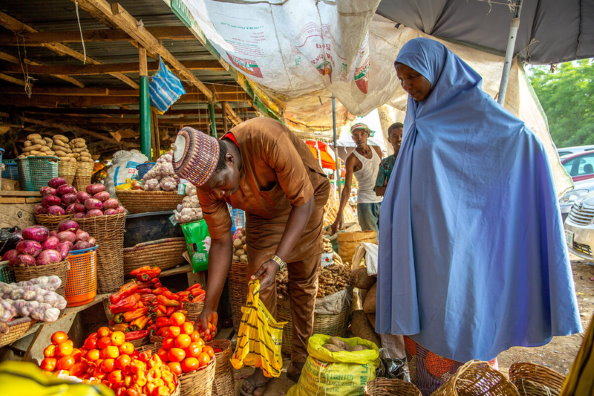By Zuhumnan Dapel
Recent inflation numbers from Nigeria are mounting serious concern over the rising cost of food in the country. But this is not Nigerians’ first encounter with food prices running hot. The spikes date back roughly three decades. Between January 2003 and August 2021, the food inflation rate has raced to three major peaks. The first and highest was about 38 per cent in August 2005, more than 16 years ago. The second, about 21 per cent, was in July 2008. The third – the second-highest in 20 years – was about 23 per cent in March 2021.
But who is feeding off the swelling food prices? Many Nigerians, including the President, are of the view that the middlemen in the food market are not only distorting and contributing to this inflation but benefiting from it. However, the emerging facts seem to be painting an entirely different picture. There has been an underlying factor, predating Buhari’s presidency, but finding flourishing ground during his administration.
- Seinye Lulu-Briggs chairs international fund for civil society
- Don’t punish Africa for Omicron, other coronavirus variants – Adesina
Crunching the numbers
I obtained and used monthly data from the Nigerian National Bureau of Statistics (NBS) showing the 43 frequently consumed food items in Nigeria—gari (Cassava flour), rice, maize, beans, red oil, vegetable oil, meat, chicken, eggs, potatoes, yam, fish, etc. The data covers all 36 states in the country, including the federal capital, from January 2017 to August 2021.
I classified the states into two categories: the five states with the highest average food prices and the five states with the lowest average food prices. Here, I observed a pattern: all the states with the lowest food prices are in the North (Kano, Katsina, Gombe, Kebbi, and Niger) and all the states with the highest food prices are in the South (Imo, Anambra, Rivers, Enugu, and Bayelsa).
Manifestly, the North appears to comparative advantage in food production, but they are still not able to feed themselves. Using NBS household survey data from between September 2018 and October 2019, and an annual food poverty line of N81,767, you can see that the food poverty rate in the North (22 per cent) is about three times that of the South (4 per cent). To put this in perspective, more than 25 million northern residents are unable to spend roughly N200 per day on food, compared to just four million in the South. This amount is not enough to buy a small-sized cup of Starbucks coffee in the United States, but it can, depending on location, pay for one and a half haircuts in Nigeria.
Who are the winners and losers of rising food prices in Nigeria?
To answer this question, we need to set out a context as follows. Rising average diesel prices in food-cheap states are linked to rising food prices in expensive food states. Food items are usually transported via diesel-powered vehicles (e.g., trucks) rather than using petrol-powered vehicles. Since vehicles transporting food items from the North to the South will usually fill up their fuel tanks while in the originating region (the North), it is therefore plausible to compare diesel prices in the North with food prices in the South (or the North-South price differences).
Worthy of note: the recent sharp, steady spike in food prices started in August 2019. Nationally, between this period and August of 2021, average food prices rose by roughly 18 per cent, but lower in the north (8 per cent) and highest in the south: 25 per cent. Apparently, the south is driving the rise in national food prices as it contributes 78 per cent to the overall increase, paying five times more in food prices than the north.
Since the South is driving nearly 80 per cent of the country’s rising food prices and given that there is a strong connection between food prices in the South and diesel prices in the North, then the cost of transportation (proxied by diesel prices) is contributing to the North-South food price differences. That means consumers of food items transported from the North to the South are paying a substantial part of the food inflation burden. They are the “losers!” And, neither are northern farmers the winners because food prices in the south are higher than food prices in the north by an amount almost equivalent to the cost of transporting the food items from the North to the South. Therefore, the likely winners may be living offshore—the oil marketers and those supplying refined petroleum products to Nigeria—given that about 80 per cent of the diesel is being imported.
The rise of the dollar
There is a widely held view among many Nigerians regarding the forces at the roots of rising food prices in their country: that the depreciating value of their local currency is responsible for the food inflation. There is some partial (or grain of) truth in this claim.
Based on my analysis of a 2019 survey by the NBS, 32 per cent of Nigerian households reported buying imported rice, spending only three per cent of their entire food expenditure on foreign rice. By default, the price of imported rice is expected to rise with the rising value of the dollar.
On the other hand, it’s a partial truth because locally cultivated (not imported) food items such as gari, white maize grain, yam, etc., together are responsible for 85 per cent of the surge in food prices between August 2019 and September 2021.
Conclusion: the way forward
In charting a way forward, two things can be done. First, close the inter-regional price differences (which may lower the national food prices) by setting up a more efficient transport system that connects the two major regions of the country. One of the ongoing railroad projects in the country linking Nigeria’s two commercial capitals: Lagos in the south near the Atlantic Ocean and Kano in the distant north (the region with a comparative advantage in producing food items) is a welcome development.
Second, since Nigeria imports over 80 per cent of its currently consumed petroleum products, local pump prices of petrol and diesel must be divorced from changes in international oil prices if they must be kept stable. One way to bring this to fruition is for the country to refine its total demand for diesel and petrol.
This brings to fore the forthcoming Dangote refinery, which is expected to be the largest in the world. Whatever support is necessary from the government should be given without hesitation. If its take-off is successful, the refinery will not only bring about a positive discrete shift in Nigeria’s oil industry but will also play a key role in revamping Africa’s largest economy.
However, there are two vital questions that Mr Dangote, the federal government of Nigeria, and their dealmakers, must provide clear answers to. First, the refinery is expected to pump and refine 650,000 barrels of crude oil per day. Will it pay for the oil in dollars? Otherwise, the refinery will cut Nigeria’s flow of foreign exchange by over $60 billion annually. This is based on my estimate using data on oil prices and oil production.
Second, how will he set the pump price of his petroleum products? If the government steps back from its refining business, Mr Dangote, as the leading investor in the oil industry, could possibly rule the Nigerian oil market. But he can be checked via an unvarnished regulatory process. It is hoped that, if all goes well, the refinery will stabilise the local pump price of petroleum products and possibly lower the average cost of transportation across the country..
Dr Dapel writes via [email protected]

 Join Daily Trust WhatsApp Community For Quick Access To News and Happenings Around You.
Join Daily Trust WhatsApp Community For Quick Access To News and Happenings Around You.


